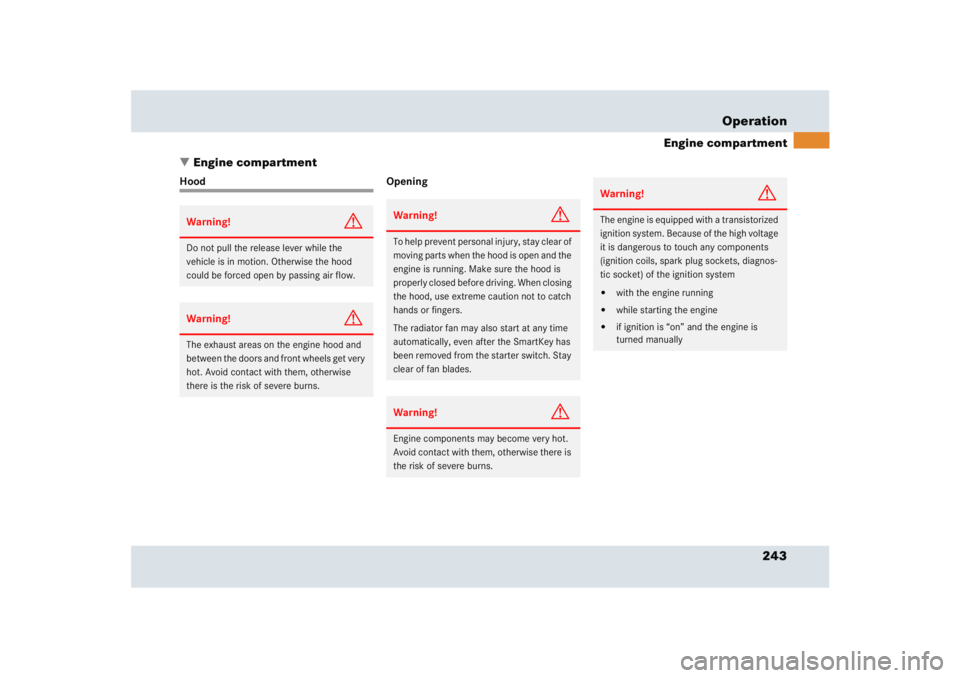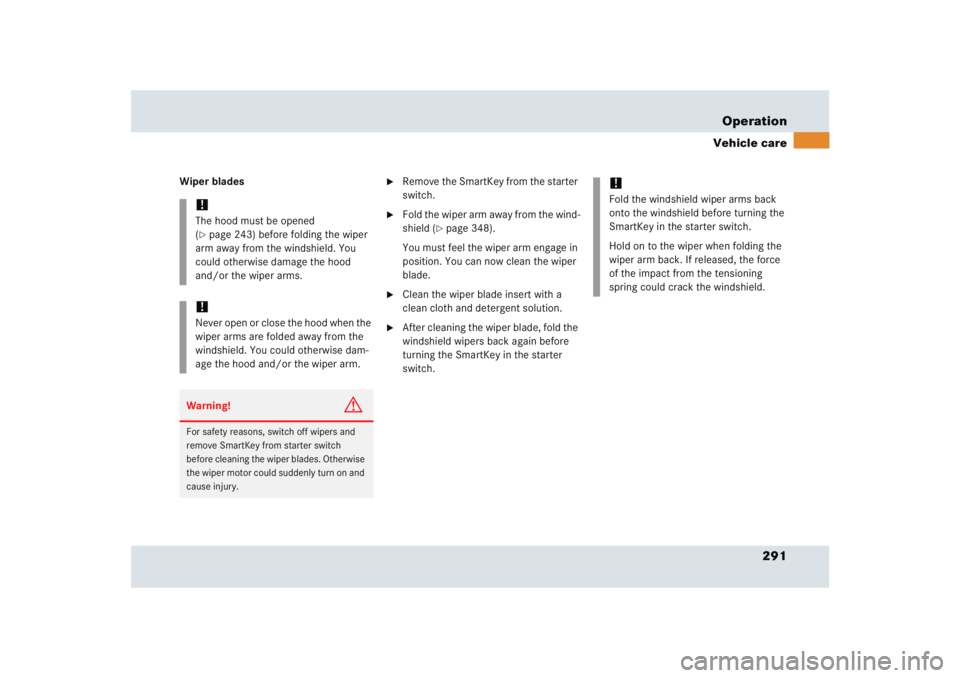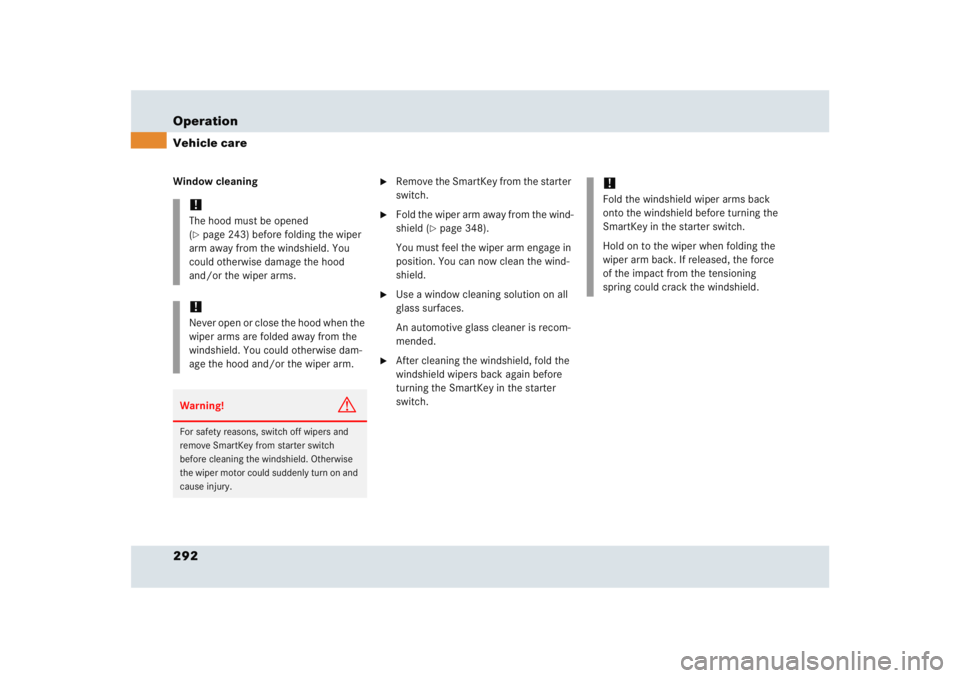Page 242 of 417

241 Operation
At the gas station
�
Replace fuel cap by turning it
clockwise.
You will hear when fuel cap is
tightened.
�
Close the fuel filler flap until you hear
the latch close shut.
Check regularly and before a long trip
1Coolant
2Engine oil
3Brake fluidCoolant
For normal replenishing, use water (pota-
ble water quality). For more information,
see “Coolant” (
�page 249) and see “Fu-
els, coolants, lubricants, etc.”
(
�page 375).
Engine oil level
For more information on engine oil level,
see “Engine oil” (
�page 246).
Brake fluid
iMore information on gasoline can be
found in the Factory Approved Service
Products pamphlet.
Leaving the engine running and the fuel
cap open can cause theú malfunc-
tion indicator lamp (USA only) or
the± malfunction indicator lamp
(Canada only) to illuminate.
For more information, see “Practical
hints” (
�page 299).
iOpening the hood, see (
�page 243).
!If you find that the brake fluid in the
brake fluid reservoir has fallen to the
minimum mark or below, have the
brake system checked for brake pad
thickness and leaks immediately.
Notify an authorized Mercedes-Benz
Center immediately. Do not add brake
fluid as this will not solve the problem.
For more information, see “Practical
hints” (
�page 298).
Page 244 of 417

243 Operation
Engine compartment
�Engine compartment
Hood OpeningWarning!
G
Do not pull the release lever while the
vehicle is in motion. Otherwise the hood
could be forced open by passing air flow.Warning!
G
The exhaust areas on the engine hood and
between the doors and front wheels get very
hot. Avoid contact with them, otherwise
there is the risk of severe burns.
Warning!
G
To help prevent personal injury, stay clear of
moving parts when the hood is open and the
engine is running. Make sure the hood is
properly closed before driving. When closing
the hood, use extreme caution not to catch
hands or fingers.
The radiator fan may also start at any time
automatically, even after the SmartKey has
been removed from the starter switch. Stay
clear of fan blades.Warning!
G
Engine components may become very hot.
Avoid contact with them, otherwise there is
the risk of severe burns.
Warning!
G
The engine is equipped with a transistorized
ignition system. Because of the high voltage
it is dangerous to touch any components
(ignition coils, spark plug sockets, diagnos-
tic socket) of the ignition system�
with the engine running
�
while starting the engine
�
if ignition is “on” and the engine is
turned manually
Page 245 of 417
244 OperationEngine compartmentThe release lever is located in the driver's
footwell.
1Release leverThe hood folding mechanism is disengaged
in two stages.
�
Pull release lever1 downwards.
This completes the first stage.
!Make sure the windshield wipers are
not folded away from the windshield.
Otherwise the windshield wipers or the
hood could be damaged.
Make sure there is sufficient clearance
before opening the hood. A minimum
clearance in front of the vehicle of 3/4ft (25 cm) is required.
iIf it was not possible to release the
hood, pull the release lever downwards
more firmly.
Page 246 of 417
245 Operation
Engine compartment
2Hood latch
The hood latches are located in the upper
air intake next to the headlamp units. �
Pull the hood latches2.
This completes the second stage.
�
Pull the hood towards you to the stop.
�
Press the front part of the hood.
The hood opens and will automatically
be held in position by gas-filled spring
struts.!Make sure there is sufficient clearance
before opening the hood. A minimum
overhead clearance of 6.6 ft (2.0 m) is
required.
Page 250 of 417

249 Operation
Engine compartment
Coolant
The engine coolant is a mixture of water
and anticorrosion/antifreeze. To check
the coolant level, the vehicle must be
parked on level ground and the engine
must be cool.
The coolant expansion tank is located on
the passenger side of the engine compart-
ment.
1Expansion tank
�
Using a rag, turn cap slowly approxi-
mately one half turn to the left to
release any excess pressure.
�
Continue turning the cap to the left and
remove it.
The coolant level is correct if the level �
for cold coolant: reaches the upper
mark on the bracing rib of the ex-
pansion tank (arrow)
�
for warm coolant: is approximately
0.4 in (1 cm) higher
�
Add coolant as required.
�
Replace and tighten cap.
For more information, see “Coolants”
(
�page 380).
Warning!
G
In order to avoid any possibly serious burns:�
Use extreme caution when opening the
hood if there are any signs of steam or
coolant leaking from the cooling system,
or if the coolant temperature gauge indi-
cates that the coolant is overheated.
�
Do not remove pressure cap on coolant
reservoir if coolant temperature is
above 194°F (90°C). Allow engine to
cool down before removing cap. The
coolant reservoir contains hot fluid and
is under pressure.
�
Using a rag, slowly open the cap
approximately
1/2 turn to relieve excess
pressure. If opened immediately, scald-
ing hot fluid and steam will be blown out
under pressure.
�
Do not spill antifreeze on hot engine
parts. Antifreeze contains ethylene
glycol which may burn if it comes into
contact with hot engine parts.
Page 292 of 417

291 Operation
Vehicle care
Wiper blades
�
Remove the SmartKey from the starter
switch.
�
Fold the wiper arm away from the wind-
shield (
�page 348).
You must feel the wiper arm engage in
position. You can now clean the wiper
blade.
�
Clean the wiper blade insert with a
clean cloth and detergent solution.
�
After cleaning the wiper blade, fold the
windshield wipers back again before
turning the SmartKey in the starter
switch.
!The hood must be opened
(�page 243) before folding the wiper
arm away from the windshield. You
could otherwise damage the hood
and/or the wiper arms.
!Never open or close the hood when the
wiper arms are folded away from the
windshield. You could otherwise dam-
age the hood and/or the wiper arm. Warning!
G
For safety reasons, switch off wipers and
remove SmartKey from starter switch
before cleaning the wiper blades. Otherwise
the wiper motor could suddenly turn on and
cause injury.
!Fold the windshield wiper arms back
onto the windshield before turning the
SmartKey in the starter switch.
Hold on to the wiper when folding the
wiper arm back. If released, the force
of the impact from the tensioning
spring could crack the windshield.
Page 293 of 417

292 OperationVehicle careWindow cleaning
�
Remove the SmartKey from the starter
switch.
�
Fold the wiper arm away from the wind-
shield (
�page 348).
You must feel the wiper arm engage in
position. You can now clean the wind-
shield.
�
Use a window cleaning solution on all
glass surfaces.
An automotive glass cleaner is recom-
mended.
�
After cleaning the windshield, fold the
windshield wipers back again before
turning the SmartKey in the starter
switch.
!The hood must be opened
(�page 243) before folding the wiper
arm away from the windshield. You
could otherwise damage the hood
and/or the wiper arms.
!Never open or close the hood when the
wiper arms are folded away from the
windshield. You could otherwise dam-
age the hood and/or the wiper arm. Warning!
G
For safety reasons, switch off wipers and
remove SmartKey from starter switch
before cleaning the windshield. Otherwise
the wiper motor could suddenly turn on and
cause injury.
!Fold the windshield wiper arms back
onto the windshield before turning the
SmartKey in the starter switch.
Hold on to the wiper when folding the
wiper arm back. If released, the force
of the impact from the tensioning
spring could crack the windshield.
Page 301 of 417

300 Practical hintsWhat to do if ...Problem
Possible cause
Suggested solution
D
The red coolant warning lamp
comes on when the engine is
running.
There is insufficient coolant in the reservoir.
�
Immediately add coolant to prevent
engine from overheating
(�page 249).
If this warning lamp comes on frequently,
there is a leak in the cooling system.
�
Have the cooling system checked by
an authorized Mercedes-Benz Center.
If the coolant level is correct, the electric
radiator fan may be broken.
�
If the coolant temperature is below
248°F (120°C), you can continue
driving to the nearest authorized
Mercedes-Benz Center.
�
Avoid high engine loads (e.g. driving
uphill) and stop-and-go driving.
D
The red coolant warning lamp
comes on while driving and you
hear a warning sound.
The coolant temperature has exceeded
248°F (120°C).
�
Stop as soon as possible and allow
the engine and coolant to cool down.
Warning!
G
Driving when your engine is badly overheat-
ed can cause some fluids which may have
leaked into the engine compartment to
catch fire. You could be seriously burned.
Steam from an overheated engine can cause
serious burns and can occur just by opening
the engine hood. Stay away from the engine
if you see or hear steam coming from it.
Turn off the engine, get out of the vehicle
and do not stand near the vehicle until the
engine has cooled down.